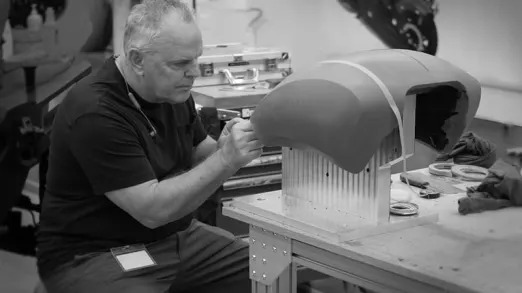It all sounds so simple: A loping V-twin engine coddled tightly by frame rails, mounted in between two suspended wheels and topped by a tank and, in most cases, a single saddle. The reality of the all-new 2025 Indian Scout, of course, is much more complicated. Autoblog recently attended a virtual introduction to the latest motorcycle from Indian, and we heard a lot of what you’d probably expect — details about the liquid-cooled 1,250cc SpeedPlus engine with up to 111 horsepower and 82 pound-feet of torque, a compact steel tube frame and lots of talk about the need for a full line of accessories.
But what really piqued our interest was when Ola Stenegard, director of product design for Indian Motorcycle, focused our attention on the art of turning design sketches into clay models. A decidedly old-school approach, we thought. It turns out Stenegard could talk for days about the art of motorcycle design, and much of what he has to say traces its roots all the way back to the famed designer Harley Earl.
“The use of automotive clay was a very American thing. It started way back in the ’20s actually, but I think it got big in the ’30s when Harley Earl went to General Motors,” Stenegard told us. “He brought clay with him.”


And it turns out the method of clay modeling “is actually still the main way to develop shapes in the automotive as well as motorcycle industries,” says Stenegard. “A lot of people think that computers or AI have taken over, but it couldn’t be further from the truth.”
It’s not that computer-aided design techniques aren’t useful, however. “Doing the details, that’s where CAD is superior,” Stenegard told us. “Badges, triple trees, wheels. … Today, those details — that’s where we use the computer power, the modeling.”
“When I was still designing hands-on, we learned how to clay model as part of our education,” Stenegard told us. “But there’s a saying that you can’t be a good sketcher and a good clay modeler, and it’s true. The modelers are the hands of the designer. There’s a symbiosis. We have clay modelers, CAD modelers too. They are phenomenal. They translate [design sketches] into reality, and that’s important to highlight.”


Just as interestingly, Stenegard and his team didn’t just rely on old-school techniques. They were also inspired by classic American car designs.
“That’s why the clay process was important — it enabled Detroit to explore a whole new era of surfacing,” said Stenegard. “And for me, the American cars were absolutely stunning. Look at the late-’30s Zephyr, or if you go into the end of the ’50s — a ’59 Cadillac — if you look at the surfacing, the fins, the details, it’s just phenomenal. Or with Lincoln, a ’64 or ’65 Lincoln, the slab-sided cars. To do the whole bodyside clean, there’s not one inch that’s flat or boring. It’s a clean car. If you examine that, it’s a beautifully modeled surface, but there’s no edges.


“So that was our inspiration. Keep it clean, keep it simple. But to really put the work into the surfacing, to make it beautiful.
“The more you simplify it, the harder it gets. Doing a super bike with a lot of edges and creases is almost easier than something clean and clear.”







